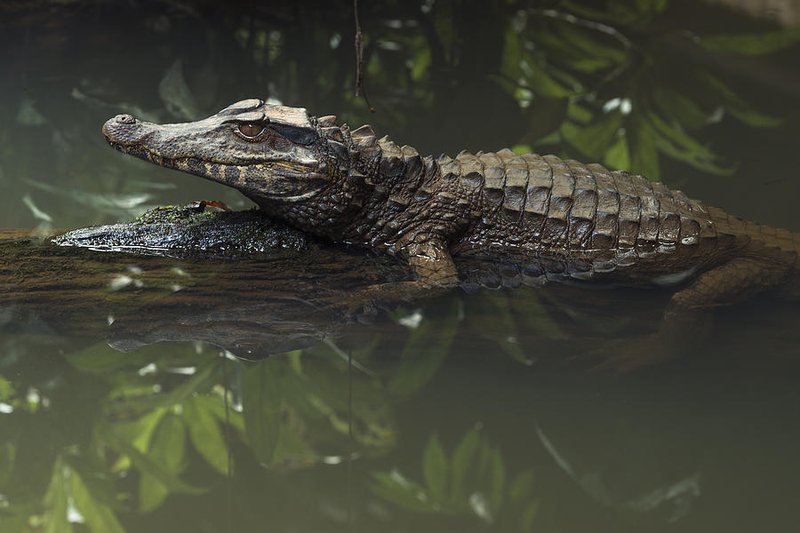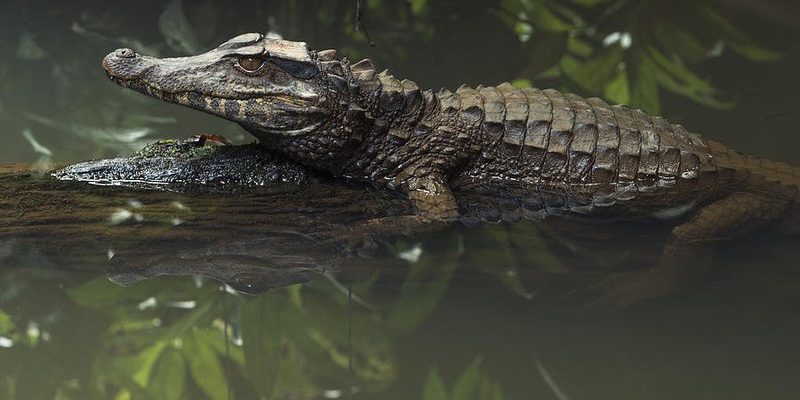
The Dwarf Caiman is a fascinating creature that often flies under the radar, even among reptile enthusiasts. Imagine a miniature crocodile, gliding silently through the waters of the Amazon Basin—this little guy packs a surprising amount of personality into its compact form. With its small size and elusive nature, the dwarf caiman captures our imagination and curiosity, prompting many to seek out more information about its lifestyle and habitat.
When you think of caimans, you might picture their larger relatives, but the dwarf caiman is unique. It stands out not just for its size but also for its behavior. From its habitat preferences to its diet, every aspect of its life is a testament to adaptation and survival in the wild. So, whether you’re planning an expedition to its native habitat or simply want to learn more about these charming reptiles, you’re in the right place. Let’s dive into the world of the dwarf caiman!
Physical Characteristics
The dwarf caiman is the smallest member of the crocodilian family, reaching an average length of just 4 to 5 feet. However, some individuals can grow slightly larger, up to about 6 feet in rare cases. This petite size makes them one of the most manageable reptiles to observe in the wild, as they often hide among the waters and vegetation of their habitats.
Its body is sleek and elongated, covered with tough, protective scales that give it a rugged appearance. These scales are often dark brown or olive green, which helps the caiman blend seamlessly into its surroundings. This camouflage is vital for both hunting and avoiding predators, as it allows the dwarf caiman to ambush unsuspecting prey without being detected.
The dwarf caiman’s jaw is another characteristic feature. It is slightly narrower than that of larger caiman species, which helps in capturing smaller fish and invertebrates—its primary food sources. With a powerful bite and sharp teeth, this reptile is well-equipped for its role as a predator in the ecosystem.
Habitat and Range
You’ll find the dwarf caiman primarily in the freshwaters of the Amazon rainforest, particularly in countries like Brazil, Colombia, Peru, and Venezuela. These caimans prefer slow-moving rivers, swamps, and floodplains rich in aquatic vegetation, which provides both food and shelter. The vegetation not only assists in camouflage but also offers nesting sites during the breeding season.
In these lush, green environments, dwarf caimans play a crucial role in maintaining the balance of their ecosystem. They help control populations of fish and other aquatic animals, ensuring the health of their habitat. Their presence is a sign of a thriving ecosystem, as they are sensitive to changes in water quality and habitat disruption.
However, as human activity encroaches on these pristine environments, the habitats of dwarf caimans are increasingly threatened. Deforestation, pollution, and hunting have all contributed to a decline in their populations, making conservation efforts vital for their survival.
Diet and Feeding Habits
The diet of a dwarf caiman primarily consists of fish, crustaceans, and small invertebrates. These caimans are skilled hunters, using their stealth and speed to capture prey in the water. They often lie in wait among the dense vegetation, watching for unsuspecting fish or amphibians swimming by.
Interestingly, dwarf caimans don’t have the same feeding habits as larger crocodilians. While larger caimans may take down larger mammals, the dwarf caiman is more specialized in its diet, focusing on smaller, more available food sources. This specialization helps reduce competition for food in their crowded habitats, allowing them to thrive in areas where larger predators might not succeed.
Feeding typically occurs during the early morning or late evening when temperatures are cooler and prey is more active. Like many reptiles, dwarf caimans are also opportunistic feeders, meaning they will eat whatever is available, allowing them to adapt their diet based on the environment.
Behavior and Social Structure
In terms of behavior, dwarf caimans are generally solitary creatures, although they may be seen basking together in the sun or during breeding season. Their primary activity is often at dawn and dusk, making them crepuscular. During the day, they can be quite elusive, hiding in the shadows of the water plants or submerged under the water’s surface to avoid detection.
Despite their solitary nature, these caimans can be quite vocal, especially during the breeding season. Males produce a variety of sounds to attract females, including low-frequency grunts and hisses. This vocal communication plays an essential role in their social interactions, especially when it comes to mating and territory establishment.
Interestingly, female dwarf caimans exhibit maternal behavior, unlike some larger crocodilian species. After laying eggs, a mother will often guard her nest and may even assist hatchlings in reaching the water once they break free from their shells. This nurturing behavior increases the chances of survival for the young caimans, ensuring that the next generation can thrive.
Reproduction and Lifespan
Reproduction in dwarf caimans typically occurs during the rainy season, when the water levels rise, providing a suitable environment for nesting. After a short courtship ritual, females lay around 10 to 20 eggs in a nest made of vegetation, which they create near the water’s edge. The mother stays close, guarding her young and protecting them from potential threats.
The eggs incubate for about 70 to 90 days, and once hatched, the hatchlings are around 8 to 10 inches long. The maternal instinct kicks in, and the mother assists them in getting to the water safely. This care is crucial since many hatchlings fall victim to predators before they can reach maturity.
In the wild, dwarf caimans can live for about 20 to 30 years, though some individuals in captivity have been known to live longer. Factors such as habitat quality, food availability, and predation significantly influence their lifespan. Protecting their environment is key to ensuring these remarkable reptiles can thrive for years to come.
Conservation Status
Currently, the dwarf caiman is classified as “Least Concern” by the International Union for Conservation of Nature (IUCN). However, this doesn’t mean they are out of danger. Their populations are under threat due to habitat destruction, illegal hunting, and climate change. As their natural habitats continue to shrink, the survival of these small caimans hangs in the balance.
Local conservation efforts aim to protect these animals by preserving their habitats and implementing stricter regulations on hunting. Some regions have begun to establish protected areas, ensuring that the dwarf caiman has a safe environment in which to thrive. Community involvement in conservation initiatives can have a significant impact, raising awareness about the importance of these reptiles within their ecosystems.
As wildlife enthusiasts and nature lovers, we can contribute to the preservation of dwarf caimans by supporting organizations that focus on conservation efforts and promoting sustainable practices. Every small action can lead to significant change, and it’s our responsibility to protect these unique creatures for future generations to appreciate.
| Characteristic | Details |
|---|---|
| Scientific Name | Paleosuchus palpebrosus |
| Size | 4 to 6 feet (average 4-5 feet) |
| Weight | 20 to 50 pounds |
| Diet | Fish, crustaceans, small invertebrates |
| Habitat | Freshwater rivers, swamps, and floodplains |
| Lifespan | 20 to 30 years in the wild |
| Conservation Status | Least Concern |
FAQ
What do dwarf caimans eat?
Dwarf caimans primarily feed on fish, crustaceans, and small invertebrates. They are skilled hunters, using their stealth to ambush prey in the water. Their diet can also include amphibians, depending on what is available in their environment. Since they are smaller compared to other caiman species, they focus on slightly smaller food sources that are abundant in their habitat.
Where can I see a dwarf caiman in the wild?
Dwarf caimans can be spotted in the Amazon rainforest, particularly in countries like Brazil, Colombia, Peru, and Venezuela. They thrive in freshwater rivers, swamps, and slow-moving waterways rich in vegetation. If you’re planning to look for them, consider visiting protected areas or national parks in these regions, where their habitats are preserved.
How do dwarf caimans behave in the wild?
These caimans are generally solitary and prefer to be active during dawn and dusk, which is when they hunt and forage for food. During the day, they often hide among the plants or submerged in the water to avoid detection. Despite their solitary nature, dwarf caimans can exhibit vocal behavior during the breeding season, using calls to attract mates.
Are dwarf caimans dangerous to humans?
Overall, dwarf caimans are not considered a significant threat to humans. Their smaller size means they do not pose the same risks as larger crocodilians. However, like all wild animals, they can bite if they feel threatened—so it’s essential to respect their space and observe them from a safe distance.
What is the breeding behavior of dwarf caimans?
During the rainy season, dwarf caimans engage in courtship before breeding. Females typically lay 10 to 20 eggs in nest structures made of vegetation. The mother stays close to protect the nest and assists the hatchlings in reaching the water after they emerge. This maternal care is a notable behavior among crocodilians, helping increase the survival rate of the young.
How long do dwarf caimans live?
In the wild, dwarf caimans can live for about 20 to 30 years, depending on environmental factors and threats. In captivity, where their needs are met more consistently, they might live even longer. Their lifespan is influenced by factors such as available food, habitat quality, and risks from predators.
What is the conservation status of dwarf caimans?
The dwarf caiman is currently classified as “Least Concern” by the IUCN, but their populations are threatened by habitat destruction, illegal hunting, and climate change. Conservation efforts are crucial to ensuring their continued survival, emphasizing the importance of habitat preservation and sustainable practices.
Can dwarf caimans be kept as pets?
While it might seem appealing to keep a dwarf caiman as a pet due to their smaller size, it’s important to remember that they are still wild animals with specific habitat and dietary needs. Keeping them in captivity requires knowledge, proper conditions, and legal permits in many regions. It’s usually best to appreciate these creatures in their natural environments or through reputable sanctuaries.
What distinguishes dwarf caimans from other caiman species?
The most notable difference is their size. Dwarf caimans are the smallest caiman species, typically reaching around 4 to 5 feet in length. They also have a narrower jaw and different dietary habits compared to their larger relatives, which often prey on larger animals. Their smaller size and specialized diet make them unique within the caiman family.
How can I help with dwarf caiman conservation?
You can support conservation efforts by getting involved with organizations focused on protecting wetland habitats and preserving crocodilian species. Additionally, promoting awareness about the challenges these creatures face and advocating for sustainable practices can help ensure a future for dwarf caimans. Every small action contributes to their protection and the preservation of their ecosystems.
What threats do dwarf caimans face?
Dwarf caimans face several threats, primarily due to human activities. Habitat destruction from deforestation and pollution significantly impacts their living conditions. Furthermore, illegal hunting for skin and meat further reduces their populations. Climate change also poses a risk, affecting their habitats and food sources. Addressing these threats through conservation efforts is crucial for their survival.

